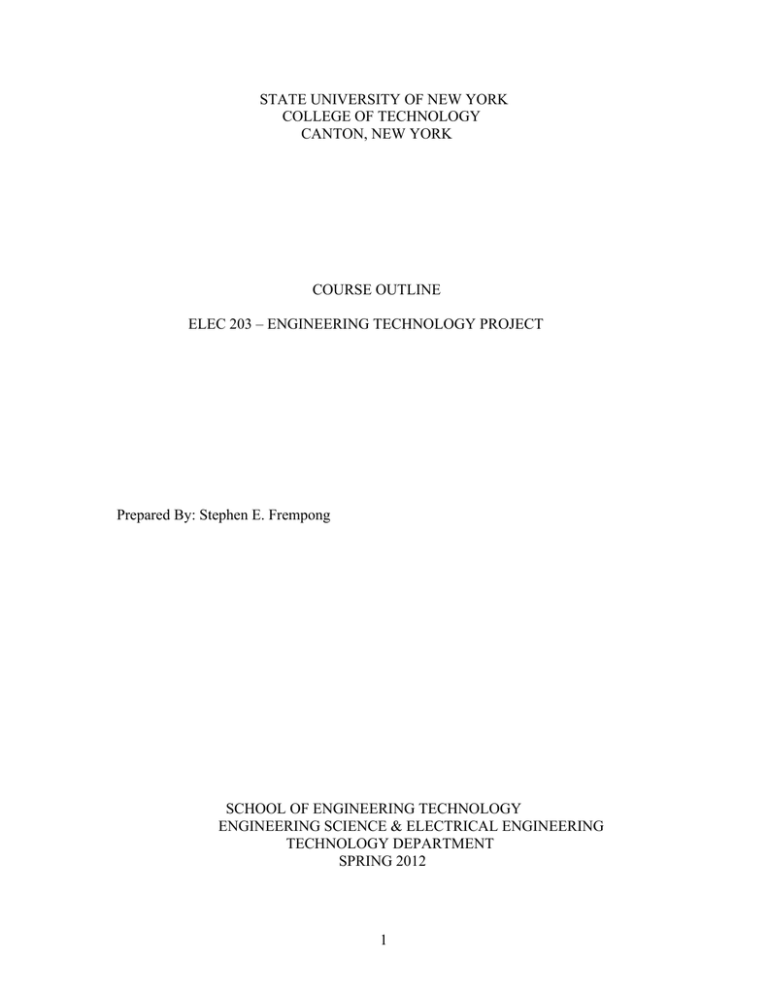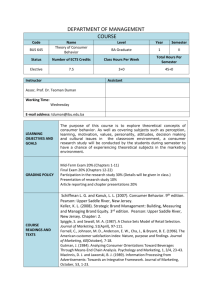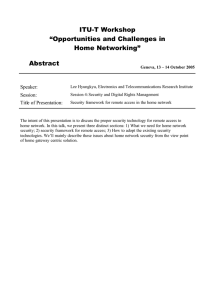ELEC 203 Engineering Technology Project
advertisement

STATE UNIVERSITY OF NEW YORK COLLEGE OF TECHNOLOGY CANTON, NEW YORK COURSE OUTLINE ELEC 203 – ENGINEERING TECHNOLOGY PROJECT Prepared By: Stephen E. Frempong SCHOOL OF ENGINEERING TECHNOLOGY ENGINEERING SCIENCE & ELECTRICAL ENGINEERING TECHNOLOGY DEPARTMENT SPRING 2012 1 ELEC 203 – ENGINEERING TECHNOLOGY PROJECT A. TITLE : ENGINEERING TECHNOLOGY PROJECT B. COURSE NUMBER: ELEC 203 C. CREDIT HOURS: 1 D. WRITING INTENSIVE COURSE: NO E. WEEKS PER SEMESTER: 15 F. SEMESTER OFFERED: SPRING G. HOURS OF LECTURE, LABORATORY, RECITATION, TUTORIAL, ACTIVITY: 3- Hours Lab/Discussion H. CATALOG DESCRIPTION: Senior project (capstone) course that gives the student an opportunity to think, design, construct, and present a finished product based on knowledge/experience from previous or current courses such as electronic circuits, telecommunications, microprocessors, and industrial controls. Each team is expected to do a classroom presentation on the final project. Examples of design project: High Power Emergency Power Supply (Alternative Energy), Industrial Monitoring System (using sensing devices), and Electronics/Communication Systems. All project proposals must be approved by course instructor. I. PRE-REQUISITES/CO-COURSES: ELEC141, ELEC215, and ELEC231, or permission of instructor. J. GOALS (STUDENT LEARNING OUTCOMES) By the end of this course, the student will be able to: a. Propose a technical project based on electrical, electronics, power, and telecommunications b. Apply critical thinking in practical design project c. Design and build a working product from a theoretical knowledge, or reengineering to improve an existing device/equipment d. Perform electrical calculations, and use test equipment e. Use computer technology to research for project information f. Demonstrate presentation skills through PowerPoint g. Work as a team, share responsibilities and solve technical problems 2 Institutional Student Learning Objectives (SLO) (1) Communication (2) Critical Thinking (3) Professional Competence (4) Inter-Intrapersonal Skills Course Objectives a. Propose a technical project based on electrical, electronics, power, and telecommunications b. Apply critical thinking in practical design project c. Design and build a working product from a theoretical knowledge, or re-engineering to improve an existing device/equipment d. Perform electrical calculations, and use test equipment e. Use computer technology to research for project information f. Demonstrate presentation skills through PowerPoint g. Work as a team, share responsibilities and solve technical problems Institutional SLO 2. Critical Thinking 3. Professional Competence 2. Critical Thinking 2. Critical Thinking 3. Professional Competence 2. Critical Thinking 3. Professional Competence 1. Communication 4. Inter-Intrapersonal Skills h. TEXTS: No textbook required. L. REFERENCES Timothy J. Maloney, Modern Industrial Electronics, 5stEdition. Upper Saddle River, New Jersey: Prentice-Hall, 2004. Robert T. Paynter, Introductory Electronic Devices and Circuits, 7thEdition. Upper Saddle River, New Jersey: Prentice-Hall, 2006. Jeffrey S. Beasley, and Gary M. Miller, Modern Electronic Communication, 8thEdition. Upper Saddle River, New Jersey: Prentice-Hall, 2005. Joseph J. Carr, and John M. Brown, Introduction to Biomedical Equipment 4thEdition. Upper Saddle River, New Jersey: Prentice- Hall, 2001. M. EQUIPMENT: Regular EET laboratory will be used 3 N. O. P. GRADING METHOD: (P/F, A-F, etc.) A-F MEASUREMENT CRITERIA/METHODS: Final grade is based on the Following: Proposal, Weekly Updates, Team problem solving capabilities, Quality of work, Project demonstration, Presentation skills, and Final paper DETAILED TOPICAL OUTLINE I. Team project proposal submission II. Project approval III. Project management software introduction IV. Project research discussion V. Final paper requirements and discussion VI. Project design VII. Obtain components needed VIII. Project updates/questions and answers (every two weeks) IX. Weekly construction and testing X. Final paper submission and class presentation (PowerPoint) XI. Project demonstration XII. Final discussion by instructor 4


